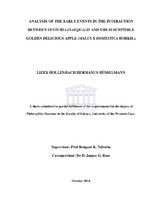| dc.description.abstract | Apple (Malus x domestica) production in the Western Cape, South Africa, is one of the major contributors to the gross domestic product (GDP) of the region. The production of apples is affected by a number of diseases. One of the economically important diseases is apple scab that is caused by the pathogenic fungus, Venturia inaequalis. Research to introduce disease resistance ranges from traditional plant breeding through to genetic manipulation. Parallel disease management regimes are also implemented to combat the disease, however, such strategies are increasingly becoming more ineffective since some fungal strains have become resistant to fungicides. The recently sequenced apple genome has opened the door to study the plant pathogen interaction at a molecular level. This study reports on proteomic and transcriptomic analyses of apple seedlings infected with Venturia inaequalis. In the proteomic analysis, two-dimensional gel electrophoresis (2-DE) in combination with mass spectrometry (MS) was used to separate, visualise and identify apple leaf proteins extracted from infected and uninfected apple seedlings. Using MelanieTM 2-DE Gel Analysis Software version 7.0 (Genebio, Geneva, Switzerland), a comparative analysis of leaf proteome expression patterns between the uninfected and infected apple leaves were conducted. The results indicated proteins with similar expression profiles as well as qualitative and quantitative differences between the two leaf proteomes. Thirty proteins from the apple leaf proteome were identified as differentially expressed. These were selected for analysis using a combination of MALDI-TOF and MALDI-TOF-TOF MS, followed by database searching. Of these spots, 28 were positively identified with known functions in photosynthesis and carbon metabolism (61%), protein destination and storage (11%), as well as those involved in redox/response to stress, followed by proteins involved in protein synthesis and disease/defence (7%), nucleotide and transport (3%). RNA-Seq was used to identify differentially expressed genes in response to the fungal infection over five time points namely Day 0, 2, 4, 8 and 12. cDNA libraries were constructed, sequenced using Illumina HiScan SQTM and MiSeqTM instruments. Nucleotide reads were analysed by aligning it to the apple genome using TopHat spliceaware aligner software, followed by analysis with limma/voom and edgeR, R statistical packages for finding differentially expressed genes. These results showed that 398 genes were differentially expressed in response to fungal infection over the five time points. These mapped to 1164 transcripts in the apple transcripts database, which were submitted to BLAST2GO. Eighty-six percent of the genes obtained a BLAST hit to which 77% of the BLAST hits were assigned GO terms. These were classed into three ontology categories i.e. biological processes, molecular function and cellular components. By focussing on the host responsive genes, modulation of genes involved in signal perception, transcription, stress/detoxification, defence related proteins, transport and secondary metabolites have been observed. A comparative analysis was performed between the Day 4 proteomic and Day 4 transcriptomic data. In the infected and uninfected apple leaf proteome of Day 4, we found 9 proteins responsive to fungal infection were up-regulated. From the transcriptome data of Day 4, 162 genes were extracted, which mapped to 395 transcripts in the apple transcripts. These were submitted to BLAST2GO for functional annotation.
Proteins encoded by the up-regulated transcripts were functionally categorised. Pathways affected by the up-regulated genes are carbon metabolism, protein synthesis, defence, redox/response to stress. Up-regulated genes were involved in signal perception, transcription factors, stress/detoxification, defence related proteins, disease resistance proteins, transport and secondary metabolites. We found that the same pathways including energy, disease/defence and redox/response to stress were affected for the comparative analysis. The results of this study can be used as a starting point for targeting host responsive genes in genetic manipulation of apple cultivars. | en_US |

